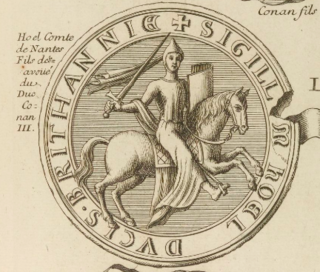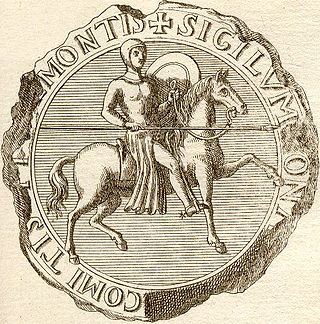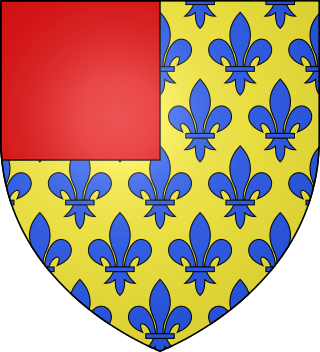Related Research Articles

Geoffrey II was Duke of Brittany and 3rd Earl of Richmond between 1181 and 1186, through his marriage to Constance, Duchess of Brittany. Geoffrey was the fourth of five sons of Henry II of England and Eleanor, Duchess of Aquitaine.

The Duchy of Brittany was a medieval feudal state that existed between approximately 939 and 1547. Its territory covered the northwestern peninsula of Europe, bordered by the Atlantic Ocean to the west, and the English Channel to the north. It was also less definitively bordered by the river Loire to the south, and Normandy, and other French provinces, to the east. The Duchy was established after the expulsion of Viking armies from the region around 939. The Duchy, in the 10th and 11th centuries, was politically unstable, with the dukes holding only limited power outside their own personal lands. The Duchy had mixed relationships with the neighbouring Duchy of Normandy, sometimes allying itself with Normandy, and at other times, such as the Breton–Norman War, entering into open conflict.
Constance was Duchess of Brittany from 1166 to her death in 1201 and Countess of Richmond from 1171 to 1201. Constance was the daughter of Duke Conan IV by his wife, Margaret of Huntingdon, a sister of the Scottish kings Malcolm IV and William I.
Hoël II was Count of Kernev, from 1058 as Hoël V. On the basis of his marriage to Hawise, Duchess of Brittany, in 1066, he became Duke of Brittany jure uxoris.

Alan IV was Duke of Brittany from 1072 until his abdication in 1112. He was also Count of Nantes and Count of Rennes. His parents were Duchess Hawise and Duke Hoel II. He is also known as Alan Fergant. Through his father, he was of the Breton House of Cornouaille dynasty. He was the last Breton-speaking Duke of Brittany.

Conan III, also known as Conan of Cornouaille and Conan the Fat was duke of Brittany, from 1112 to his death. He was the son of Alan IV, Duke of Brittany and Ermengarde of Anjou.

Hoèl of Cornwall was count of Nantes, from 1148 to his death. He was raised the son of Duke Conan III and Maud FitzRoy, an illegitimate daughter of King Henry I of England. However, he was disinherited by his father when on his death-bed, as Conan III claimed that Hoèl was illegitimate and no son of his. Bertha then became heiress to Duke Conan's lands in Brittany, while Hoèl was allowed to remain Count of Nantes. He was accused by St. Bernard of Clairvaux of having an incestuous affair with his sister Bertha.
Odo II, Count of Porhoet was the son of Geoffroy, Viscount de Porhoët, and his wife Hawise. He became Duke of Brittany in 1148, jure uxoris, upon his marriage to Bertha, Duchess of Brittany.

Conan IV, called the Young, was the Duke of Brittany from 1156 to 1166. He was the son of Bertha, Duchess of Brittany, and her first husband, Alan, Earl of Richmond. Conan IV was his father's heir as Earl of Richmond and his mother's heir as Duke of Brittany. Conan and his daughter Constance would be the only representatives of the House of Penthièvre to rule Brittany.

Guy of Thouars was the third husband of Constance, Duchess of Brittany, whom he married in Angers, County of Anjou between August and October 1199 after her son Arthur of Brittany entered Angers to be recognized as count of the three countships of Anjou, Maine and Touraine. He was an Occitan noble, a member of the House of Thouars. He is counted as a duke of Brittany, jure uxoris, from 1199 to 1201.

John I, known as John the Red due to the colour of his beard, was Duke of Brittany from 1221 to his death and 2nd Earl of Richmond in 1268.

The now-extinct title of Earl of Richmond was created many times in the Peerage of England. The earldom of Richmond was initially held by various Breton nobles; sometimes the holder was the Breton duke himself, including one member of the cadet branch of the French Capetian dynasty. The historical ties between the Duchy of Brittany and this English earldom were maintained ceremonially by the Breton dukes even after England ceased to recognize the Breton dukes as earls of England and those dukes rendered homage to the King of France, rather than the English crown. It was then held either by members of the English royal families of Plantagenet and Tudor, or English nobles closely associated with the English crown. It was eventually merged into the English crown during the reign of Henry VII of England and has been recreated as a Dukedom.

The term Angevin Empire describes the possessions held by the House of Plantagenet during the 12th and 13th centuries, when they ruled over an area covering roughly all of present-day England, half of France, and parts of Ireland and Wales, and had further influence over much of the remaining British Isles. It may be described as an early example of a composite monarchy. The empire was established by Henry II of England, who succeeded his father Geoffrey as Duke of Normandy and Count of Anjou. Henry married Eleanor of Aquitaine in 1152, acquiring the Duchy of Aquitaine, and inherited his mother Empress Matilda's claim to the English throne, succeeding his rival Stephen in 1154. Although their title of highest rank came from the Kingdom of England, the Plantagenets held court primarily on the continent at Angers in Anjou, and at Chinon in Touraine.
The counts of Nantes were originally the Frankish rulers of the Nantais under the Carolingians and eventually a capital city of the Duchy of Brittany. Their county served as a march against the Bretons of the Vannetais. Carolingian rulers would sometimes attack Brittany through the region of the Vannetais, making Nantes a strategic asset. In the mid-ninth century, the county finally fell to the Bretons and the title became a subsidiary title of the Breton rulers. The control of the title by the Breton dukes figured prominently in the history of the duchy. The County of Nantes was given to Hoel, a disinherited son of a duke. He lost the countship due to a popular uprising. That uprising presented an opportunity for King Henry II of England to attack the Breton duke. In the treaty ending their conflicts, the Breton duke awarded the county to Henry II.

The Diocese of Nantes is a Latin Church diocese of the Catholic Church in Nantes, France. The diocese consists of the department of Loire-Atlantique. It has existed since the 4th century. It is now suffragan of the Archdiocese of Rennes, Dol, and Saint-Malo, having previously been suffragan to the Archdiocese of Tours. Its see is Nantes Cathedral in the city of Nantes.
Bertha of Cornouaille, also known as Bertha of Brittany, was the Duchess of Brittany between 1148 until her death and Dowager Countess of Richmond. Bertha was the elder daughter of Conan III of Brittany by Maude, the illegitimate daughter of King Henry I of England. She was the last member of the Breton house of Cornouaille to reign over Brittany.
Margaret of Huntingdon was a Scottish princess and Duchess of Brittany. She was the sister of Scottish kings Malcolm IV and William I, wife of Conan IV, Duke of Brittany, and the mother of Constance, Duchess of Brittany. Her second husband was Humphrey de Bohun, hereditary Constable of England. Following her second marriage, Margaret styled herself as the Countess of Hereford.

Henry II, also known as Henry Fitzempress and Henry Curtmantle, was King of England from 1154 until his death in 1189. During his reign he controlled England, substantial parts of Wales and Ireland, and much of France, an area that altogether was later called the Angevin Empire, and also held power over Scotland and the Duchy of Brittany.
Matthew II was the Count of Nantes from 1084 until his death. He was the second son of Duke Hoël II of Brittany and Hawise. He was named for his father's cousin, Count Matthew I of Nantes, perhaps on the presumption that he would inherit Nantes.
The English invasion of France of 1230 was a military campaign undertaken by Henry III of England in an attempt to reclaim his family rights and inheritance to the territories of France, held prior to 1224. The English army did not seek battle with the French, did not invade the Duchy of Normandy and marched south to the County of Poitou. The campaign on the continent ended in a fiasco, Henry made a truce with Louis IX of France and returned to England. The failure of the campaign led to the dismissal of Hubert de Burgh, 1st Earl of Kent as Justiciar.
References
- ↑ "Diocese of Nantes". GCatholic. Retrieved 27 September 2024.
- ↑ Everard, p. 67.
- ↑ Torigny, p. 312.